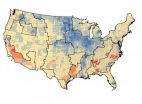(Press-News.org) People spend 3 billion hours a week playing videogames but little is known scientifically about why they are actually fun in the first place.
The vast majority of research into videogames has concentrated on the possible harmful effects of playing videogames, ignoring the simple question of why people actually want to play them.
But new research led by scientists at the University of Essex sheds some light on the appeal of videogames and why millions of people around the world find playing them so much fun.
The study investigated the idea that many people enjoy playing videogames because it gives them the chance to "try on" characteristics which they would like to have as their ideal self.
The research is part of ongoing work by Dr. Andy Przybylski, a visiting research fellow at Essex, into how videogames affect people by trying to understand what draws so many people to such a wide variety of games.
Due to be published in an upcoming issue of Psychological Science, a journal of the Association for Psychological Science, the research found that gaming was the ideal platform for people to "try on different hats" and take on a characteristic they would like to have.
"A game can be more fun when you get the chance to act and be like your ideal self," explained Dr. Przybylski. "The attraction to playing videogames and what makes them fun is that it gives people the chance to think about a role they would ideally like to take and then get a chance to play that role."
The research found that giving players the chance to adopt a new identity during the game and acting through that new identity – be it a different gender, hero, villain – made them feel better about themselves and less negative.
Looking at the players' emotion after play as well their motivation to play, the study found the enjoyment element of the videogames seemed to be greater when there was the least overlap between someone's actual self and their ideal self.
"When somebody wants to feel they are more outgoing and then plays with this personality it makes them feel better in themselves when they play," explained Dr. Przybylski.
Working with co-author Dr. Netta Weinstein, also from Department of Psychology at Essex, and academics in Germany and the United States, Dr. Przybylski's research involved hundreds of casual game players in the laboratory and studied nearly a thousand dedicated gamers who played everything from The Sims and Call of Duty to World of Warcraft. Players were asked how they felt after playing in relation to the attributes or characteristics of the persona they would ideally like to be.
Inspired by his games as a child with imaginative play, Dr. Przybylski was curious to see if the findings showed that games were used as a way of players escaping from themselves.
"However, I was heartened by the findings which showed that people were not running away from themselves but running towards their ideals. They are not escaping to nowhere they are escaping to somewhere."
###
For more information about this study, please contact: Andrew Przybylski at aprzyby@essex.ac.uk.
The APS journal Psychological Science is the highest ranked empirical journal in psychology. For a copy of the article "The ideal self at play: The appeal of videogames that let you be all you can be" and access to other Psychological Science research findings, please contact Divya Menon at 202-293-9300 or dmenon@psychologicalscience.org.
Getting to the heart of the appeal of video games
2011-08-04
ELSE PRESS RELEASES FROM THIS DATE:
UI biologist finds one species of pathogen can produce two distinct biofilms
2011-08-04
Many medical devices, ranging from artificial hip joints to dentures and catheters, become sites for unwelcome guests -- complex communities of microbial pathogens called biofilms that are resistant to the human immune system and antibiotics, thus proving a serious threat to human health.
However, researchers may have a new way of looking at biofilms, thanks to a study conducted by University of Iowa biologist David Soll and his colleagues published in the Aug. 2 issue of the online, open access journal PLoS Biology.
Previously, researchers believed that each pathogen ...
USDA scientists study effects of rising carbon dioxide on rangelands
2011-08-04
This press release is available in Spanish.
Rising carbon dioxide (CO2) levels can reverse the drying effects of predicted higher temperatures on semi-arid rangelands, according to a study published today in the scientific journal Nature by a team of U.S. Department of Agriculture (USDA) and university scientists.
Warmer temperatures increase water loss to the atmosphere, leading to drier soils. In contrast, higher CO2 levels cause leaf stomatal pores to partly close, lessening the amount of water vapor that escapes and the amount of water plants draw from soil. ...
Mayo Clinic examines why knee osteoarthritis afflicts more women than men
2011-08-04
JACKSONVILLE, Fla. — A Mayo Clinic orthopedic surgeon suspects that the nagging pain and inflammation that women can experience in their knees may be different from what men encounter, and she has been chosen to lead a novel U.S.-Canadian study to explore the question. The Society for Women's Health Research (SWHR) and its Interdisciplinary Studies in Sex-Differences (ISIS) Network on Musculoskeletal Health has awarded a group of researchers a $127,000 grant to lead a pilot project to understand whether biological differences between men and women affect the incidence and ...
Carbon hitches a ride from field to market
2011-08-04
RICHLAND, Wash. – Today, farming often involves transporting crops long distances so consumers from Maine to California can enjoy Midwest corn, Northwest cherries and other produce when they are out of season locally. But it isn't just the fossil fuel needed to move food that contributes to agriculture's carbon footprint.
New research published in the journal Biogeosciences provides a detailed account of how carbon naturally flows into and out of crops themselves as they grow, are harvested and are then eaten far from where they're grown. The paper shows how regions that ...
'Watermark ink' device identifies unknown liquids instantly
2011-08-04
Cambridge, Mass. - August 3, 2011 - Materials scientists and applied physicists collaborating at Harvard's School of Engineering and Applied Sciences (SEAS) have invented a new device that can instantly identify an unknown liquid.
The device, which fits in the palm of a hand and requires no power source, exploits the chemical and optical properties of precisely nanostructured materials to distinguish liquids by their surface tension.
The finding, published in the Journal of the American Chemical Society (JACS), offers a cheap, fast, and portable way to perform quality ...
UGA researchers use gold nanoparticles to diagnose flu in minutes
2011-08-04
Arriving at a rapid and accurate diagnosis is critical during flu outbreaks, but until now, physicians and public health officials have had to choose between a highly accurate yet time-consuming test or a rapid but error-prone test.
A new detection method developed at the University of Georgia and detailed in the August edition of the journal Analyst, however, offers the best of both worlds. By coating gold nanoparticles with antibodies that bind to specific strains of the flu virus and then measuring how the particles scatter laser light, the technology can detect influenza ...
GEN reports on nanotechology's impact on mass spectrometry
2011-08-04
New Rochelle, NY, August 3, 2011—A move toward smaller and smaller sample sizes is leading to a new generation of mass spectrometry instrumentation, reports Genetic Engineering & Biotechnology News (GEN). From a specific application point of view, novel nanoflow separation methodologies are ramping up the speed and precision with which scientists are able to validate biomarkers, according to the August issue of GEN (www.genengnews.com/gen-articles/nanoliter-volumes-push-ms-to-new-lows/3741).
"Basing biomarker validation on more sophisticated mass spec tools could help ...
Researchers develop and test new molecule as a delivery vehicle to image and kill brain tumors
2011-08-04
RICHMOND, Va. (Aug. 3, 2011) – A single compound with dual function – the ability to deliver a diagnostic and therapeutic agent – may one day be used to enhance the diagnosis, imaging and treatment of brain tumors, according to findings from Virginia Commonwealth University and Virginia Tech.
Glioblastomas are the most common and aggressive brain tumor in humans, with a high rate of relapse. These tumor cells often extend beyond the well-defined tumor margins making it extremely difficult for clinicians and radiologists to visualize with current imaging techniques. Researchers ...
New study calls into question reliance on animal models in cardiovascular research
2011-08-04
Anyone who follows science has read enthusiastic stories about medical breakthroughs that include the standard disclaimer that the results were obtained in mice and might not carry over to humans.
Much later, there might be reports that a drug has been abandoned because clinical trials turned up unforeseen side effects or responses in humans. Given the delay, most readers probably don't connect the initial success and the eventual failure.
But Igor Efimov, PhD, a biomedical engineer at Washington University in St. Louis who studies the biophysical and physiological ...
Bellybutton microbiomes
2011-08-04
Public awareness about the role and interaction of microbes is essential for promoting human and environmental health, say scientists presenting research at the Ecological Society of America's (ESA) 96th Annual Meeting from August 7-12, 2011. Researchers shed light on the healthy microbes of the human body and other research on microbial and disease ecology to be presented at ESA's 2011 meeting in Austin, Texas.
Bellybutton microbiomes
Human skin is teeming with microbes—communities of bacteria, many of which are harmless, live alongside the more infamous microbes sometimes ...



